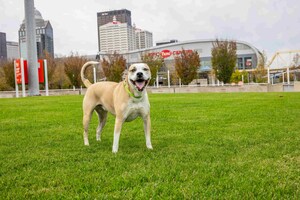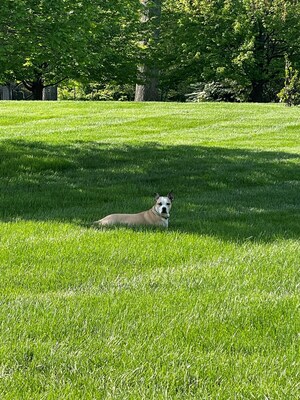The TurfMutt Foundation Shares 5 Reasons We Need More Yards, Parks and Community Green Space
Myriad Scientific Data Proves Green Space Is Good for People & the Planet
ALEXANDRIA, Va., May 6, 2024 /PRNewswire/ -- For 15 years the TurfMutt Foundation has advocated for the care and use of yards, parks, and other green spaces. These outdoor areas facilitate "backyarding," the act of taking every day activities that we normally do inside into the outdoor spaces around us such as dining, working, relaxing and more. This not only makes life more enjoyable, but it also improves the health and well-being of people pets and the planet.
"Over the years, we've seen the benefits to families, communities and wildlife by having accessible green space to help balance our man-made environments," said TurfMutt CEO & President Kris Kiser. "The benefits of nature – which starts right out our backdoors – are vast, and there is a wealth of scientific evidence to support the argument for growing our green space."
Here are the top 5 reasons we need more managed green space in our backyards and communities:
Environmental Benefits
Plants, shrubs, trees, and grass are "environmental superheroes" that capture and filter rainwater, produce oxygen, and absorb carbon. The dense canopy and fibrous root system in a lawn sequesters carbon so well that it outweighs the carbon used for maintaining the grass by as much as seven-fold. An average-sized home lawn in the U.S. has the potential to sequester 20.3 to 163.4 kg C/lawn/year. Planting trees results in less runoff and erosion, allowing more recharging of the ground water supply and resulting in less sediment and chemicals in streams.
Physical Well-Being
The physical health benefits of spending time in green space are vast. A review of research published between 1976 and 2017 found consistent associations between greater urban green space exposure and decreased mortality, heart rate, and violence, as well as between greater urban green space exposure and increased attention, mood, and physical activity. Living near green spaces could add 2.5 years to your life, according to research published in the peer-reviewed journal Science Advances. Additionally, people living near green spaces, including parks, age slower than those in dense urban environments.
Mental Health
Spending time in green space also makes us happier and improves our mental well-being. According to a systematic review of research, green spaces decrease the risk of psychiatric disorders, including depression, anxiety, dementia, schizophrenia, and ADHD. Additionally, visits to parks, community gardens, and other urban green spaces may lower city dwellers' use of drugs for anxiety, insomnia, depression, high blood pressure, and asthma.
Financial Advantages
Having more green in your yard can add more green to your pocketbook. According to a study conducted by the Harris Poll for the TurfMutt Foundation, nearly three-quarters of Americans overall (72 percent) say a spacious yard would be at the top of their wish list if they were looking for a new home. A beautiful landscape improves curb appeal, which can increase home value by as much as 17 percent. Each front yard tree adds one percent to a homeowner's sale price, while large specimen trees can add 10 percent to property values.
Wildlife Corridors
Wildlife – including pollinating birds, butterflies, bees – have had to adapt to the human-made environment. Having the proper green space that blooms throughout the year in backyards and community parks plays a critical role in helping animals and insects thrive by reconnecting fragmented habitats into a connected ecosystem. To find the best plants to support backyard critters in your area, consult the National Wildlife Federation's Native Plant Finder.
Backyarding is most beneficial when practicing the "right plant, right place" principle. This means selecting plants that support your family's lifestyle and ones that will thrive in your climate zone with minimal work on your part. Refer to the USDA's Plant Hardiness Zone Map to find the plants, shrubs and trees that are best suited for your yard. If pets are in the picture, you will want to choose pet-friendly plantings. The ASPCA has a list of non-toxic plants that are safe for pets.
For more, sign up for Mutt Mail, a monthly e-newsletter with backyarding tips and all the news from the TurfMutt Foundation here. To learn more about creating the yard of your dreams, visit TurfMutt.com. Look for Mulligan the TurfMutt on the CBS Lucky Dog television show on Saturday mornings.
Media contact
Debbi Mayster, Four Leaf PR on behalf of the TurfMutt Foundation, 240-988-6243, [email protected]
About TurfMutt
TurfMutt, which is celebrating its 15th anniversary in 2024, was created by the Outdoor Power Equipment Institute's (OPEI) TurfMutt Foundation and has reached more than 70 million children, educators and families since 2009. Championed by Foundation spokesdog, Mulligan the TurfMutt, and through education partners such as Weekly Reader, Discovery Education and Scholastic, TurfMutt has taught students and teachers how to "save the planet, one yard at a time." Today, TurfMutt is an official USGBC® Education Partner and part of their global LEARNING LAB. TurfMutt has been an education resource at the U.S. Department of Education's Green Ribbon Schools, the U.S. Department of Energy, the U.S. Environmental Protection Agency, Green Apple, the Center for Green Schools, the Outdoors Alliance for Kids, the National Energy Education Development (NEED) project, Climate Change Live, Petfinder and the U.S. Fish and Wildlife Service. In 2017, the TurfMutt animated video series won the coveted Cynopsis Kids Imagination Award for Best Interstitial Series. TurfMutt's personal, home habitat was featured in the 2017-2020 Wildlife Habitat Council calendars. More information at www.TurfMutt.com.
SOURCE TurfMutt Foundation

WANT YOUR COMPANY'S NEWS FEATURED ON PRNEWSWIRE.COM?
Newsrooms &
Influencers
Digital Media
Outlets
Journalists
Opted In






Share this article